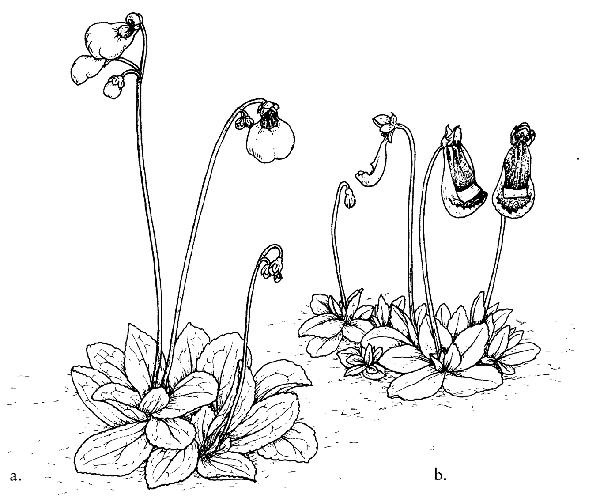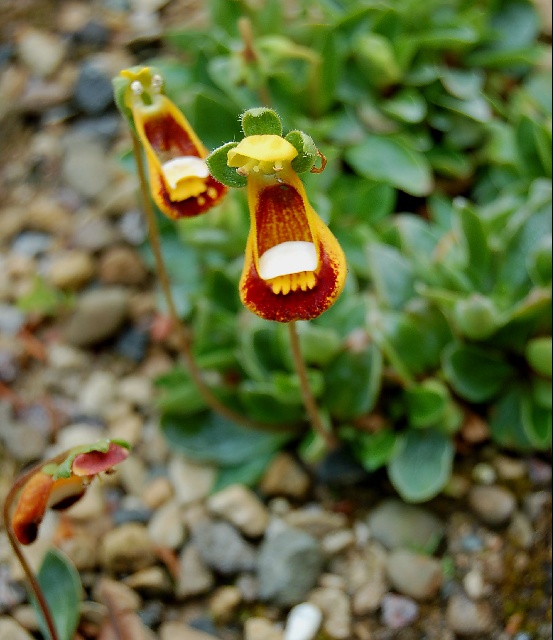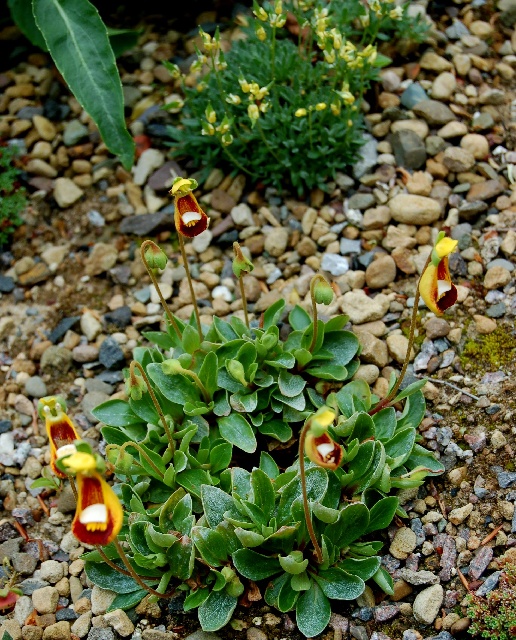Loosely tufted, cushion-forming, slightly woody at the base, 4-10cm tall. Leaves darkish-green with erect to ascending stems. Here is the plant more familiar to many as C. darwinii. Unfortunately that hallowed name has been lost to botanical priority, but is still listed as a variety in the lists for the projected 'Flora of Chile'. All varieties have oblong-spathulate to ovate-rhomboid leaves l-8cm long tapering to a winged petiole of the same length. The leaf blade may have entire or lightly crenate to denticulate margins. The rounded, slightly hooded lip about equals the minutely glandular-hairy calyx. Flower colour is a basic orange-yellow with varying amounts of deep garnet-red to bright chestnut freckling or shading in the throat and on the outside of the vertical lower lip. There is typically a shiny white horizontal band at the junction of the long throat and the rather short, wide pouch. C.u. var. uniflora has leaves that are variably hairy, but never completely glabrous; ovate calyx lobes about 5 by 3mm and occasionally a scape of up to three flowers. Its well-rounded, ovate lip measures 1.8-2.5 by 1cm The flower was originally described as pure, unmarked yellow and reported so by Farrer, but this was surely an error as no such form has ever since been found in the wild. C.u. var. darwinii has leaves always completely glabrous and much larger, the 10 by 5mm lobes to the incurved calyx with a correspondingly larger top lip; and is always solitary flowered. The very large lower lip is 3.3-2.5cm, obtriangular, fairly squared off along broad apex and somewhat scalloped or retuse. This is the classic, prized plant of cultivation. In the wild (Estancia Stag River) are silvery farinose forms, not only exciting in appearance, but claimed (by Mrs Ruth Tweedy) to be easier to grow. C.u. var. minima a microform, also always single-flowered may always be distinguished from C. fothergillii by its wider (1cm) flowers. Chile and Argentina, in southern Patagonia and Fuegia, in coastal and riverine sands and rocks, clearings in scrubland, peaty alpine fescue moorland, feldmark, clifftops and steppe, often in very exposed, well-drained sites from sea level to 1200m. Well-ventilated conditions avoiding sun-scorch or undue air stagnation, or winter damp are imperative in cultivation. Alpine house cultivation and acid leafmould compost give the best options. [Pl.73]

a, C. biflora; b, C. uniflora var. darwinii;


Sign up for our newsletter to receive our monthly update direct to your inbox. Featuring our latest articles and news.
Built by Atomic Smash

